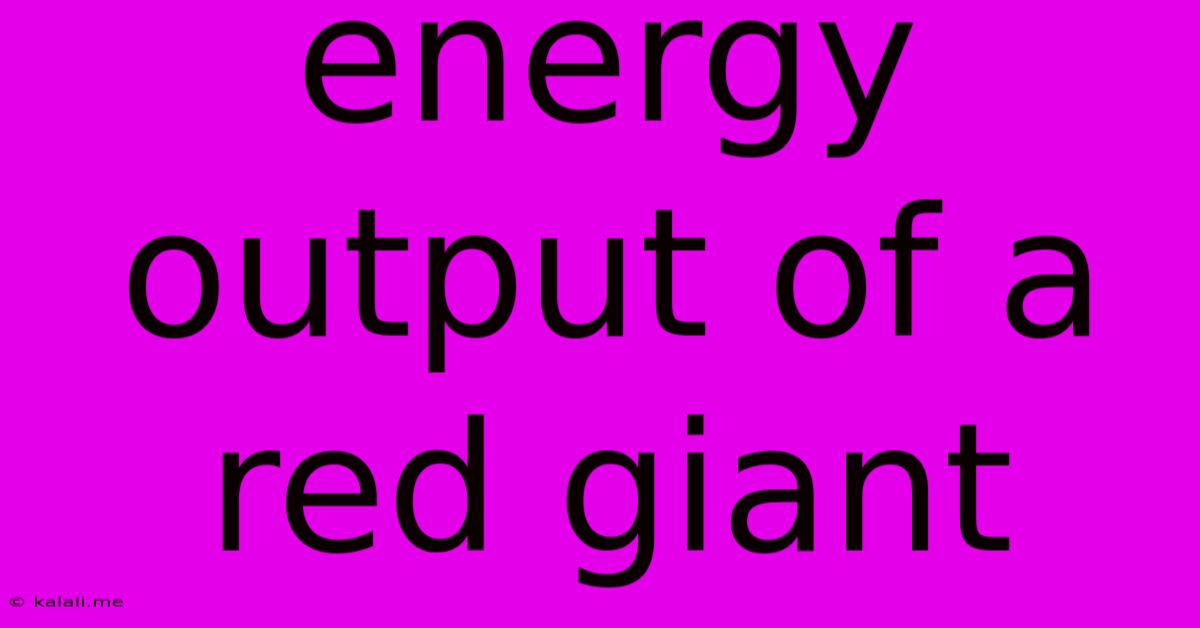Energy Output Of A Red Giant
Kalali
May 24, 2025 · 3 min read

Table of Contents
The Energetic End Game: Exploring the Energy Output of a Red Giant
Red giants represent a pivotal stage in the stellar life cycle, marking a dramatic transformation from the main sequence star we're familiar with. This article delves into the fascinating complexities of a red giant's energy production, exploring its luminosity, energy sources, and the processes that drive its evolution. Understanding these aspects is crucial to comprehending the broader context of stellar evolution and the eventual fate of stars like our Sun.
From Main Sequence Star to Red Giant: A Shift in Energy Production
A star's energy is primarily generated through nuclear fusion in its core. Main sequence stars, like our Sun, fuse hydrogen into helium, releasing vast amounts of energy in the process. However, this process is finite. Once the core hydrogen is depleted, the star embarks on a transformative journey towards becoming a red giant.
The core, now primarily composed of helium, contracts under its own gravity. This contraction increases the core temperature, initiating the fusion of helium into carbon and oxygen. This helium fusion process, known as the triple-alpha process, is significantly more energetic than hydrogen fusion. This increase in energy production dramatically alters the star's appearance and energy output.
The Increased Luminosity of a Red Giant
The most striking characteristic of a red giant is its increased luminosity. While the core temperature increases, the outer layers of the star expand dramatically, leading to a significant increase in surface area. This expansion, coupled with the more energetic helium fusion, results in a dramatic surge in the star's luminosity, often increasing by factors of hundreds or even thousands. This enhanced luminosity is what makes red giants so bright, even though their surface temperature is comparatively lower than main-sequence stars of similar mass.
Energy Transport Mechanisms in Red Giants
The energy generated in the core of a red giant must be transported to the surface. In main sequence stars, this is primarily achieved through radiative transfer. However, in red giants, convection plays a more significant role. Convective currents transport the energy more efficiently, effectively mixing the material within the star. This mixing process impacts the star's chemical composition and further influences its energy production and evolution.
The Variability of Energy Output
The energy output of a red giant isn't consistently steady. Many red giants exhibit variability in their luminosity, pulsating regularly or irregularly. These pulsations are driven by complex interactions between the star's internal structure, energy transport mechanisms, and the opacity of its outer layers. The study of these pulsations provides valuable insights into the internal workings of these evolved stars.
The Ultimate Fate: Beyond the Red Giant Phase
The red giant phase is not the final chapter in the life of a star. The ultimate fate of a red giant depends heavily on its initial mass. Lower-mass stars, like our Sun, will eventually shed their outer layers, forming a planetary nebula, leaving behind a white dwarf – a dense, hot core that gradually cools over billions of years. Higher-mass stars undergo more dramatic fates, potentially culminating in supernova explosions and the formation of neutron stars or black holes.
Conclusion: Understanding the Powerhouse Within
The energy output of a red giant is a complex interplay of nuclear fusion processes, energy transport mechanisms, and stellar structure. The increased luminosity, driven by helium fusion and stellar expansion, significantly alters the star's characteristics, making it a fascinating and important object of study in astrophysics. Further research continues to refine our understanding of these powerful celestial objects and their vital contribution to the enrichment of the interstellar medium.
Latest Posts
Latest Posts
-
How Do You Say Good Morning In Italian
May 24, 2025
-
How Long Were The Israelites In Egypt
May 24, 2025
-
Regularity Of Solutions Of Linear Ode
May 24, 2025
-
Hash Of Data Does Not Match Digest In Descriptor
May 24, 2025
-
How To Tell If Avocado Is Bad
May 24, 2025
Related Post
Thank you for visiting our website which covers about Energy Output Of A Red Giant . We hope the information provided has been useful to you. Feel free to contact us if you have any questions or need further assistance. See you next time and don't miss to bookmark.